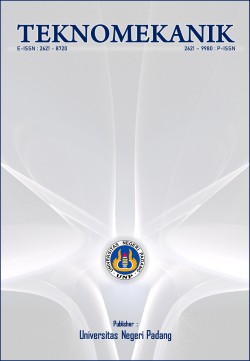Aquifer analysis with seismic methods in Parambahan Region
DOI:
https://doi.org/10.24036/jptk.v4i2.21623Keywords:
Drought, Seismic, Depth of Soil, GroundwaterAbstract
The problem faced by farmers in Parambahan Region during the dry season is agricultural land does not get adequate water supply from existing irrigation channels, as a result, farmers can only carry out agricultural activities during the rainy season in Parambahan Region Lima Kaum Subdistrict, district of Tanah Datar. This study aims to determine the location and depth of soil layers containing groundwater by using the seismic method, measurements are carried out at two points, with the length of the track at the first point being 80 meters, and at the second point 70 meters, each measurement on seismic data collection using 4 geophones as signal capture sensors, with a distance between geophones of 5 meters. The results of this study that the wave velocity at the first data point collection was 169.49 m/s and the lowest was 87.1 m / s, and the wave velocity at the second point was 129.68 m / s and the lowest was 48.07 m / s. from the wave velocity, it can be seen the type and depth of the groundwater layer at the point of data collection on the first pass, which is a depth of up to 27.5 meters of the possibility of soft soil and a depth of about 30 to 40 meters of watery soft soil at that depth may have groundwater, and at that point, the second passage at a depth of up to 25 meters is likely to be soft soil and at a depth of around 25 to 35 meters of watery soft soil at that depth, there is groundwater.
Downloads
References
Hawkins, L. V. 1961. The Reciprocal Method of Routine Shallow Seismic Refraction Investigation.Jurnal Geophysics. Volume XXVI No. 6.
Herlambang, A., 1996, Kualitas AirtanahDangkal di KabupatenBekasi, Tesis: IstitutPertanian Bogor.
Hudha, S. N. et al. (2014) ‘Penentuan Struktur Bawah Permukaan Dengan Menggunakan Metode Seismik Refraksi Di Lapangan Panas Bumi Diwak Dan Derekan, Kecamatan Bergas, Kabupaten Semarang’, Youngster Physics Journal, 3(3), pp. 263–268.
Jongmans, Denis. & Garambois, Stephane. 2007. Geophysical Investigation of Landslides. Bulletin Societe Geologique de France 178, 2. Hal-00196268.
Juanita, Retno.2011.http://juanita.blog.uns.ac.id/files/2011/01/gelombangseismik1. pdf.
Krussman, G.P. and Ridder, N.A., 1970. Analysis and Evaluation of Pumping Test Data. International Institute for Land Reclamation and Improvement, Wageningen
Nurdiyanto, B. Drajat, N. Sunardi, B. DanSusilanto, P. (2011), Penentuan Tingkat Kekerasan BatuanMenggunakan Metode Seismik Refraksi, Jurnal Meteorologi Dan Geofisika Vol. 12 No. 3, Desember 2011:211- 220.
Priyantari, N. & Suprianto, A. 2009. Penentuan Kedalaman BedrockMenggunakan Metode Seismik Refraksi di Desa Kemuning Lor Kecamatan Arjasa Kabupaten Jember, Jurnal ILMU DASAR Vol. 10 No.1 . 2009: 6 – 12.
Rucker, M.L. 2006. Integrating Seismic Refraction And Surface Wave Data Collection And Interpretation For Geotechnical Site Characterization. Geophysics Conference, St. Louis, Missouri, USA.
Siswoyo, H. et al. (2018) ‘Penyelidikan Potensi Air Tanah Pada Lahan Pertanian Di Desa Bono Kecamatan Pakel Kabupaten Tulungagung Dengan Menggunakan Metode Potensial Diri’, DINAMIKA REKAYASA, 14(2), pp. 112–118.
Susilawati. 2004. Seismikrefraksi (dasarteoridanakuisisi data), USU Digital Library.
Taib, M. I. T. 2000. SeismikRefraksi. Bandung. InstitutTekhnologi Bandung Press.
Tipler, Paul. A; alih bahasa, Bambang Soegijono; editor, Wibi Hardani. 2001. Fisika Untuk Sains Dan Teknik. Jakarta: Erlangga.
Todd, D.K. dan Mays, L.W. 2005.Groundwater Hydrology (Third Edition). John Wiley and Sons, In. New York.
Y. Arbi, R. leonardo Siregar, and Tri Padmi Damanhuri, “kajian pencemaran air tanah oleh lindi di sekitar air dingin kota padang,” Sains dan Teknol. J. Keilmuan dan Apl. Teknol. Ind., vol. 18, no. 1, pp. 46–52, 2018.
Y. Arbi and E. R. Aidha, “simulation of mercury transport from gold mining activities in pelawan river, Sarolangun,” in 4th International Conference on Technical and Vocation Education and Training, 2017, vol. 4, pp. 567–571.
Downloads
Published
How to Cite
Issue
Section
License
Copyright (c) 2021 Yaumal Arbi, Ari Syaiful Rahman Arifin, Muvi Yandra

This work is licensed under a Creative Commons Attribution 4.0 International License.





